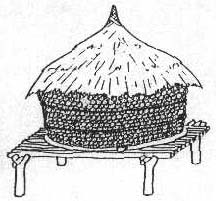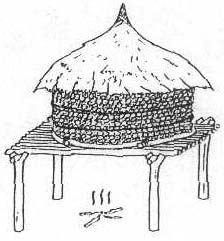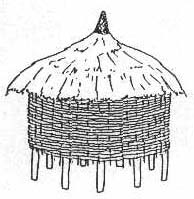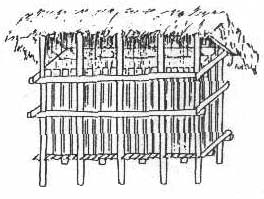Navigation
An improved method for storing maize, Togo's main cereal crop
Slightly changing the construction methods of traditional maize storage granaries can result in significantly reduced insect infestation and mildew losses for small farmers
Location:
Rural areas, Togo
Summary:
Slightly changing the construction methods of traditional maize storage granaries can result in significantly reduced insect infestation and mildew losses for small farmers.
Problem Overview:
Cereal losses after harvesting
The main cereal grown in Togo is maize, 95% of which is produced by small-scale farmers who suffer substantial losses because of insects and mildew. Inadequate storage facilities compound the problem.
Background:
The use of a thatched structure (granary) to store maize is a traditional practice in the West African countries of Ivory Coast, Ghana, Togo, Benin and Nigeria. It may well be used in other countries, although no definite information on this is available. It is not known who originally developed this system or when. However, the structure was first systematically studied by a multidisciplinary research team from the University of Benin in Togo in 1983 under the direction of Dr. Philip J. Smith. The team developed a series of methods to improve maize storage, thereby increasing farmers' income by minimizing losses. Improved storage also increases the amount of food available to families during the year.
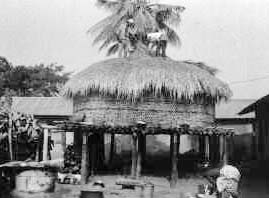 |
A typical smallholder farmer in the region under consideration is faced with the problem of quickly clearing his field towards the end of August (when labor is in short supply) in order to prepare the land for a second planting. Maize harvested at this time contains moisture content levels ranging from 18 to 25% and must continue to dry if it is to be stored successfully for extended periods. However, these moisture content levels do not allow the maize to be easily shelled by hand, as the kernels are still too soft. This precludes artificial drying as an immediate solution to the drying and storage problem even if the technical facilities were available and the necessary laborers could be found. Faced with these constraints, the farmer has chosen the traditional granary as an inexpensive solution to his/her immediate drying and storage problems.
The new methods incorporate these traditional granaries, which are made from harvested cobs and straw. They are used for both storing and drying. The methods described below are recommended to increase the quality and quantity of maize (click to view schematic chart of wall construction and stacking pattern):
- Seeding in rows (with generous spacing between) and early harvesting increase the quantity of corn and limit insect infestation. In very humid regions, a late harvest is recommended because of mildew problems.
- Granaries should be built in sunny areas on cleared land three metres away from the nearest building to minimize infiltration by rodents. Wire netting can be placed between the posts supporting the granaries to keep rats out
- In humid areas, granaries should be raised off the ground (1.2-1.6 m) and fumigated. Elsewhere, or when fumigation is not carried out, granaries should be kept low (35-50 cm above ground).
- The recommended size for small granaries is 2-5 m wide and 1-2 m high.
- The walls of maize are reinforced every five or six rows by wrapping them with creepers or rope.
- A conical roof made from plaited straw should cover the maize.
- Sorting before storage will remove any cobs that have already been damaged by insects or mildew. Studies show that sorting the cobs reduces the amount of damage in the granaries by 36%.
- A combination of Neem tree leaves, a thin layer of ash, and fumigation create a hostile environment for insects.
- Granaries are more effective for drying when the base platform lets air easily pass through, when cobs on the wall are positioned tightly together, and when the roof is well woven and correctly placed.
- Once the maize is dry it is recommended that the cobs are shelled and the grains stored in a more permanent storage system.
Types of Maize Storage Structures | ||
low granary | ||
high granary | ||
woven wall granary | ||
rectangular crib | ||
Schematic representation of the four basic types of maize storage structures which were studied. In practice the platform base of the first three structures may be circular or rectangular, flat or concave. | ||
Implementation Status:
Farmers in Togo have shown great interest in the research findings, which involve no major changes to their usual methods and little extra cost. These simple methods increase the harvest and improve the quality of the maize. Thanks to improved methods, farmers have noted losses of 9%, compared to between 15-50% using traditional methods.
Impact
- Influence on the University of Benin - At the end of the project an Endogenous Technologies Research Centre (ETRC) was created at the university by the project team.
The specific objectives of ETRC are:
- to undertake research and verification trials in the field on results obtained;
- to ensure a liaison between the university and rural farmers by disseminating research results to policy makers, researchers, and extension workers;
- to ensure the training of rural trainers in improved traditional technologies. In addition, a course in "The Traditional Storage of Agricultural Products" is now being offered at the university.
- Influence on development organizations - The concept that the granary is a maize dryer seems to have been accepted by research and development organizations. Current development efforts are oriented towards encouraging the use of a properly constructed granary for about three months, then shelling the cobs, and using a more permanent storage system for longer-term storage.
- Influence on researchers - IDRC advocates a systems approach to research. This concept is described in a paper entitled, "A Systems Approach to the Classification of Experiments" (See DOCUMENTATION). It will be interesting to evaluate the response of researchers and IDRC to this document in years to come.
- Dissemination - An illustrated manual in French called "Stockage traditionnel du maïs" was produced for extension workers and brochures written in local languages were prepared for farmers. A documentary video entitled The Traditional Granary, produced in English, French, and Ewe, has been broadcast in over 20 African countries on the CFI (Francophone) and URTNA (Anglophone) broadcast networks. (See DOCUMENTATION)
Potential Users
Small maize producers in West Africa.
Constraining Factors
If the granary is built correctly and used as a temporary drying and storage structure for two to three months there appears to be little problem with its use, as insect attack levels remain low. However, many farmers wish to continue to use this structure to store maize for up to eight months. Under these conditions insect attack levels increase dramatically, especially with the larger grain borer Prostephanus truncatus. It should also be noted that initial granary construction requires a supply of wood for the posts and platform. In order to avoid long-term problems, some tree planting is required for this reason.
Documentation:
Stockage traditionnel du maïs. (Illustrated manual in French for farmers aided by extension workers, available from Nouvelles Editions Africaines du Togo, 239 Bd. du 13 Janvier, Lomé, Togo, Afrique de l'Ouest.)
The Traditional Granary. (A twenty-minute documentary video in English, French and Ewe; available via Contact information above)
In the IDRC library:
Etudes togolaises des systemes traditionnels de stockage du maïs en zone tropicale guinienne. 1990. 450 pp.: ill. (Final report.) Location: ARCHIV 633.15:631.563(668.1) S 6 BIBLIO ISN: 53037
Etudes togolaises de stockage de maïs en milieu rural. 1986. 5 v.: ill. Location: ARCHIV 633.15:631.56 K 65 BIBLIO ISN: 69140
Participatory action research in Togo: an inquiry into maize storage systems. Participatory research. 1990. ARCHIV MACLUR no. 01 BIBLIO ISN: 86576 - Available from the Endogenous Technologies Research Centre, University of Benin, PO Box 1515, Lome, Togo:
Smith, Philip J., Homa S. Smith, Kwami G. Kpakote, "An Evaluation of the Drying Mechanisms of Maize Storage Structures Used in Southern Togo."
Smith, Philip J., Homa S. Smith, Kwami G. Kpakote, "A Systems Approach to a Classification of Experiments."
Submitted by:
CONTACTS Philip J. Smith
Ecole superieure d'agronomie
Université de Benin
PO Box 1515
Lomé, TOGO
Fax: +228 21.85.95
Telex: UNIVERBENIN 5258 UB TO
Telegram: UNIVERBENIN
E-mail: phismith@syfed.tg.refer.org
International organizations:
Natural Resources Institute
Food Security Department - Food Storage Group
Central Avenue, Chatham Maritime
Kent ME4 4TB, UNITED KINGDOM
Tel.: 01634 880088 (National), +44 1634 880088 (International)
Fax: 01634 880066/77 (National), +44 1634 880066/77 (International)
E-mail: http://www.solutions-site.org/cgi-bin/artman/exec/Helen.Bowles@nri.org
Web site: http://www.nri.org/capstats/fsdfsg.htm
Canadian International Development Agency (CIDA):
Country Program Manager for Benin and Togo
Christian Tardif
200 Promenade du Portage Hull, Quebec Canada K1A 0G4
Tel: (819) 953-2272
Fax: (819) 953-9454
E-Mail: christian_tardif@acdi.cida.gc.ca
Regional Director for Golfe de Guinee
Archie Book
200 Promenade du Portage Hull, Quebec Canada K1A 0G4
Tel: (819) 997-1291
Fax: (819) 953-9454
E-mail: archie_book@acdi.cida.gc.ca
World University Service of Canada (WUSC):
Dominique Bédard, Regional director for West Africa
eumc.ben@bow.intnet.bj
Marc Dolgin, USC Executive Director
1404 Scott Street Ottawa, Ontario K1Y 4 M8
e-mail: wusc@wusc.ca
Website: http://www.wusc.ca/
Phone: (613) 798-7477
Fax: (613) 798-0990
Endogenous Technologies Research Centre at the University of Benin - Centre de Recherches sur les Technologies Endogènes Université du Bénin
B.P. 1515, Lomé, TOGO
crte-ub@syfed.tg.refer.org
Information Date: 1998-02-06
Information Source: International Development Research Centre
Search
Latest articles
Agriculture
- World Water Week: Healthy ecosystems essential to human health: from coronavirus to malnutrition Online session Wednesday 24 August 17:00-18:20
- World Water Week: Healthy ecosystems essential to human health: from coronavirus to malnutrition Online session Wednesday 24 August 17:00-18:20
Air Pollution
- "Water and Sanitation-Related Diseases and the Changing Environment: Challenges, Interventions, and Preventive Measures" Volume 2 Is Now Available
- Global Innovation Exchange Co-Created by Horizon International, USAID, Bill and Melinda Gates Foundation and Others
Biodiversity
- It is time for international mobilization against climate change
- World Water Week: Healthy ecosystems essential to human health: from coronavirus to malnutrition Online session Wednesday 24 August 17:00-18:20
Desertification
- World Water Week: Healthy ecosystems essential to human health: from coronavirus to malnutrition Online session Wednesday 24 August 17:00-18:20
- UN Food Systems Summit Receives Over 1,200 Ideas to Help Meet Sustainable Development Goals
Endangered Species
- Mangrove Action Project Collaborates to Restore and Preserve Mangrove Ecosystems
- Coral Research in Palau offers a “Glimmer of Hope”
Energy
- Global Innovation Exchange Co-Created by Horizon International, USAID, Bill and Melinda Gates Foundation and Others
- Wildlife Preservation in Southeast Nova Scotia
Exhibits
- Global Innovation Exchange Co-Created by Horizon International, USAID, Bill and Melinda Gates Foundation and Others
- Coral Reefs
Forests
- NASA Satellites Reveal Major Shifts in Global Freshwater Updated June 2020
- Global Innovation Exchange Co-Created by Horizon International, USAID, Bill and Melinda Gates Foundation and Others
Global Climate Change
- It is time for international mobilization against climate change
- It is time for international mobilization against climate change
Global Health
- World Water Week: Healthy ecosystems essential to human health: from coronavirus to malnutrition Online session Wednesday 24 August 17:00-18:20
- More than 400 schoolgirls, family and teachers rescued from Afghanistan by small coalition
Industry
- "Water and Sanitation-Related Diseases and the Changing Environment: Challenges, Interventions, and Preventive Measures" Volume 2 Is Now Available
- Global Innovation Exchange Co-Created by Horizon International, USAID, Bill and Melinda Gates Foundation and Others
Natural Disaster Relief
- STOP ATTACKS ON HEALTH CARE IN UKRAINE
- Global Innovation Exchange Co-Created by Horizon International, USAID, Bill and Melinda Gates Foundation and Others
News and Special Reports
- World Water Week: Healthy ecosystems essential to human health: from coronavirus to malnutrition Online session Wednesday 24 August 17:00-18:20
- STOP ATTACKS ON HEALTH CARE IN UKRAINE
Oceans, Coral Reefs
- World Water Week: Healthy ecosystems essential to human health: from coronavirus to malnutrition Online session Wednesday 24 August 17:00-18:20
- Mangrove Action Project Collaborates to Restore and Preserve Mangrove Ecosystems
Pollution
- Zakaria Ouedraogo of Burkina Faso Produces Film “Nzoue Fiyen: Water Not Drinkable”
- "Water and Sanitation-Related Diseases and the Changing Environment: Challenges, Interventions, and Preventive Measures" Volume 2 Is Now Available
Population
- "Water and Sanitation-Related Diseases and the Changing Environment: Challenges, Interventions, and Preventive Measures" Volume 2 Is Now Available
- "Water and Sanitation-Related Diseases and the Changing Environment: Challenges, Interventions, and Preventive Measures" Volume 2 Is Now Available
Public Health
- Honouring the visionary behind India’s sanitation revolution
- Honouring the visionary behind India’s sanitation revolution
Rivers
- World Water Week: Healthy ecosystems essential to human health: from coronavirus to malnutrition Online session Wednesday 24 August 17:00-18:20
- Mangrove Action Project Collaborates to Restore and Preserve Mangrove Ecosystems
Sanitation
- Honouring the visionary behind India’s sanitation revolution
- Honouring the visionary behind India’s sanitation revolution
Toxic Chemicals
- "Water and Sanitation-Related Diseases and the Changing Environment: Challenges, Interventions, and Preventive Measures" Volume 2 Is Now Available
- Actions to Prevent Polluted Drinking Water in the United States
Transportation
- "Water and Sanitation-Related Diseases and the Changing Environment: Challenges, Interventions, and Preventive Measures" Volume 2 Is Now Available
- Urbanization Provides Opportunities for Transition to a Green Economy, Says New Report
Waste Management
- Honouring the visionary behind India’s sanitation revolution
- Honouring the visionary behind India’s sanitation revolution
Water
- Honouring the visionary behind India’s sanitation revolution
- Honouring the visionary behind India’s sanitation revolution
Water and Sanitation
- Honouring the visionary behind India’s sanitation revolution
- Honouring the visionary behind India’s sanitation revolution

